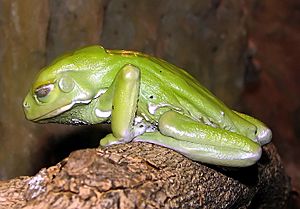Waxy monkey leaf frog facts for kids
Quick facts for kids Waxy monkey leaf frog |
|
|---|---|
 |
|
| Conservation status | |
| Scientific classification | |
| Genus: |
Phyllomedusa
|
| Species: |
sauvagii
|
The waxy monkey leaf frog (Phyllomedusa sauvagii) is a special type of frog. It is also called the waxy monkey tree frog. These frogs live in South America. You can find them in countries like Argentina, Bolivia, Paraguay, and Brazil. They are tree-dwelling animals, meaning they live mostly in the trees and plants of the Gran Chaco region.
Contents
Reproduction and Life Cycle
Waxy monkey leaf frogs have their babies during the rainy season. This usually happens from October to March. They do not mate all the time during this season. Instead, they mate right after or during heavy rain.
Male frogs find a bush or tree near water. They start making calls to attract females. When a male and female find each other, they form a pair. They work together to build a nest for their eggs.
The frog pair moves to a good spot to lay eggs. This is usually on a leaf hanging over water. The male helps the female lay her eggs. At the same time, he fertilizes them.
Where They Lay Eggs
Choosing the right place to lay eggs is very important for these frogs. Their eggs can easily dry out. So, the nest must not be too dry or in direct sunlight.
The nest must also be on a leaf over fresh water. This is so that when the baby tadpoles hatch, they can drop right into the water. Frogs often pick larger leaves for their nests. They also choose leaves that hang over standing water.
To keep the eggs from drying out, females lay empty, jelly-like capsules. These capsules surround the real eggs. They provide extra fluid for the developing babies. They also help keep the eggs from drying up. These capsules also help the frogs wrap the leaf around the eggs. Sometimes, the frogs use more than one leaf to wrap their egg clutch well.
Baby Frog Development
The eggs of the waxy monkey leaf frog are quite large. They have a lot of yolk, which is food for the growing embryo. It takes about six to nine days for the babies to develop inside the eggs.
After this time, the embryos hatch on their own. They then drop into the water below. When they hatch, the tadpoles have large external gills. These help them breathe underwater. They also have a special mouth with many rows of teeth. Their tail makes up about two-thirds of their body length. Waxy monkey leaf frog embryos can be over 20 millimeters long when they hatch.
Staying Cool and Saving Water
Waxy monkey leaf frogs can handle many different body temperatures. They can be comfortable between about 20 and 40 degrees Celsius. Their upper limit is about 40 degrees Celsius. This is higher than most frogs can stand. This ability helps them a lot. They do not need to use up their water to cool down unless it gets hotter than 40°C. These frogs can also handle temperatures as low as 20°C. They seem to prefer temperatures between 22 and 26°C.
How They Control Their Temperature
These frogs can control their body temperature. They do this by managing how much water evaporates from their skin. Like other leaf frogs, they have special ways to save water. They have a waxy, oily substance on their skin. This substance helps stop water from leaving their body. They also get rid of waste as uric acid, which uses less water than other ways.
This waxy substance is made in special glands all over the frog's body. If you handle a frog, it might use its legs to wipe itself. This might be to spread the waxy substance. It could also be to clean itself. Scientists are still studying exactly how this waxy layer works. Some think it creates a waterproof layer. Others believe it helps attract water to form a protective film.
No matter how it works, this wiping method is very good at keeping water in. These frogs lose only 5-10% of the water that other frogs lose. This is similar to how lizards save water.
Waxy monkey leaf frogs are active at night. During the day, they usually rest on a branch. When they are resting, they might enter a sleepy state called torpor. This can help them lose even less water when they breathe.
See also
 In Spanish: Rana mono encerada para niños
In Spanish: Rana mono encerada para niños



